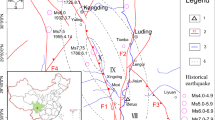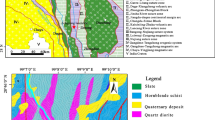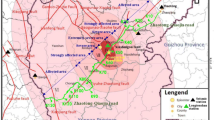Abstract
Landslide and river blocking induced by earthquakes have occurred widely in nature. The topography and geological structure of slopes have a considerable influence on the geotechnical structure of the formed landslide dam. In the Hongshiyan valley (Niulan river, Yunnan province, China), a large-scale anti-dip rock landslide was triggered by Ludian earthquake in 2014 with more than 1.36 × 107 m3 of displaced rock, which formed a barrier lake with an estimated volume of 2.6 × 108 m3. In relation to this example, the whole process from triggering, failure, disintegration, to landslide dam formation blocking a river is simulated using the discrete element method (DEM). For this, a 3D DEM modeling methodology of the complex landslide is proposed that includes an inversion strategy which uses laboratory tests of rock samples from the landslide to obtain the numerical parameters for the DEM. Initial investigations indicate that the weak slope base is an important internal factor resulting in the failure of the slope. During the earthquake, this part of the slope is the first to disintegrate and flow out under the upper rock mass pressure. This exposes the upper rock mass to large domains of tensile stress that eventually leads to the failure and disintegration of the upper hard rock mass. The anti-dip bedding of the slope results in a landslide dam consisting of "fine particles at the lower elevations and coarse rock blocks deposit at the higher elevations". Our model also suggests that the triggering and failure mode of the landslide may mostly depend on the external factors (such as earthquake, rainfall, and river erosion and so on), while the subsequent dynamic process of the landslide and the engineering geological structure of the landslide dam mainly depend on the geological structure of the slope, sliding distance and topography of the valley.
Highlights
-
A typical “weak base” anti-dip layered rock landslide induced by earthquake has been introduced.
-
A method for the 3D DEM complex model generation of landslide is proposed.
-
The whole process of the landslide and river blocking process have been studied by using DEM.
-
The geological structure of the barrier dam is controlled by the slide body, runout distance and topography of valley.
















Similar content being viewed by others
References
Barla M, Piovano G, Grasselli G (2012) Rock slide simulation with the combined finite-discrete element method. Int J Geomech 12(6):711–721
Bozzano F, Lenti L, Martino S et al (2011) Earthquake triggering of landslides in highly jointed rock masses: reconsruction of the 1783 Scilla rock avalanche (Italy). Geomrphology 129:294–308
Chang ZF, Chen XL, An XW et al (2016) Contributing factors to the failure of an unusually large landslide triggered by the 2014 Ludian, Yunnan, China, Ms = 6.5 earthquake. Nat Hazards Earth Syst Sci 16(497–507):2016
Cundall PA, Strack OD (1979) A discrete numerical model for granular assemblies. Géotechnique 29(1):47–65
Dai ZL, Huang Y, Cheng HL, Xu Q (2011) 3D numerical modeling using smoothed particle hydrodynamics of flow-like landslide propagation triggered by the 2008 Wenchuan earthquake. Eng Geol 4(180):21–33
Ding XB, Zhang LY, Zhu HH et al (2014) Effect of model scale and particle size distribution on PFC3D simulation results. Rock Mech Rock Eng 47(6):2139–2156
Donze FV, Richefeu V, Magnier SA (2009) Advances in discrete element method applied to soil rock and concrete mechanics. Electron J Geotech Eng 8:1–44
Fan XM, Juang CH, Wasowski J et al (2018) What we have learned from the 2008 Wenchuan Earthquake and its aftermath: a decade of research and challenges. Eng Geol 241:25–32
Feng ZY, Lo CM, Lin QF (2017) The characteristics of the seismic signals induced by landslides using a coupling of discrete element and finite difference methods. Landslides 14:661–674
Harp EL, Jibson RW (1996) Landslides triggered by the 1994 Northridge, California, earthquake. Bull Seismol Soc Am 86(1B):S319–S332
Ivars DM, Potyondy DO, Pierce M, Cundall PA (2008) The smooth-joint contact model. In: Proceeding of the 8th world congress on computational mechanics and 5th European congress on computational methods in applied sciences and engineering at: Venice, Italy, p 2735
Luo J, Pei XJ, Evans SG et al (2019) Mechanics of the earthquake-induced Hongshiyan landslide in the 2014 Mw 6.2 Ludian earthquake, Yunnan, China. Eng Geol 251:197–213
Keefer DK (2002) Investigating landslides caused by earthquakes—a historical review. Surv Geophys 23(6):473–510
Kozicky J, Donze FV (2009) YADE-OPEN DEM: an open-source software using a discrete element method to simulate granular material. Eng Comput 26(7):786–805
Lin CH, Lin ML (2015) Evolution of the large landslide induced by Typhoon Morakot: a case study in the Butangbunasi River, southern Taiwan using the discrete element method. Eng Geol 197:172–187
Lo CM, Lin ML, Tang CL et al (2011) A kinematic model of the Hsiaolin landslide calibrated to the morphology of the landslide deposit. Eng Geol 123(1–2):22–39
Scholtes L, Donze FV (2012) Modelling progressive failure in fractured rock masses using a 3D discrete element method. Int J Rock Mech Min Sci 52:18–30
Scholtes L, Donze FV (2015) A DEM analysis of step-path failure in jointed rock slopes. CR Mec 343:155–165
Smilauer V et al (2015) Yade documentation, 2nd ed. The Yade Project. 10.5281/zenodo.34073 (http://yade-dem.org/doc/)
Song YX, Huang D, Cen DF (2016) Numerical modelling of the 2008 Wenchuan earthquake-triggerd Daguangbao landslide using a velocity and displacement dependent friction law. Eng Geol 215:50–68
Tang CL, Hu JC, Lin ML et al (2009) The Tsaoling landslide triggered by the Chi-Chi earthquake, Taiwan: insights from a discrete element simulation. Eng Geol 106(1–2):1–19
Wang HL, Liu SQ, Xu WY et al (2020) Numerical investigation on the sliding process and deposit feature of an earthquake-induced landslide: a case study. Landslides 17:2671–2682
Wu JH (2010) Seismic landslide simulations in discontinuous deformation analysis. Comput Geotech 37(5):594–601
Wu JH, Do TN, Chen CH et al (2017) New geometric regulation for the displacement constraint points in discontinuous deformation analysis. Int J Geomech 17(5):E4016002
Wu JH, Lin WK, Hu HT (2018) Post-failure simulations of a large slope failure using 3DEC: the Hsien-du-shan slope. Eng Geol 242:92–107
Xu WJ, Xu Q, Wang YJ (2013) The mechanism of high-speed motion and damming of the Tangjiashan landslide. Eng Geol 157:8–20
Xu XW, Xu C, Yu GH et al (2015) Primary surface ruptures of the Ludian Mw 6.2 earthquake, southeastern Tibetan Plateau, China. Seismol Res Lett 86(6):1622–1635
Yamagishi H, Yamazaki F (2018) Landslides by the 2018 Hokkaido Iburi-Tobu Earthquake on September 6. Landslides 15(12):2521–2524
Zhang YB, Chen GQ, Zheng L et al (2013) Effects of near fault seismic loadings on run-out of large-scale landslide: a case study. Eng Geol 166:216–236
Zhou YY, Shi ZM, Zhang QZ et al (2019) 3D DEM investigation on the morphology and structure of landslide dams formed by dry granular flows. Eng Geol 258:105151
Acknowledgements
The authors would like to acknowledge the project of “Natural Science Foundation of China (41941019, 51879142)”, “Research Fund Program of the State Key Laboratory of Hydroscience and Engineering (2020-KY-04)”.
Author information
Authors and Affiliations
Contributions
WJX performed the numerical simulations of this study and wrote the manuscript. LW performed the laboratory test of the rock sample used in this study. KC performed the geological analysis and field investigation of the landslide.
Corresponding author
Additional information
Publisher's Note
Springer Nature remains neutral with regard to jurisdictional claims in published maps and institutional affiliations.
Rights and permissions
About this article
Cite this article
Xu, WJ., Wang, L. & Cheng, K. The Failure and River Blocking Mechanism of Large-Scale Anti-dip Rock Landslide Induced by Earthquake. Rock Mech Rock Eng 55, 4941–4961 (2022). https://doi.org/10.1007/s00603-022-02903-x
Received:
Accepted:
Published:
Issue Date:
DOI: https://doi.org/10.1007/s00603-022-02903-x




